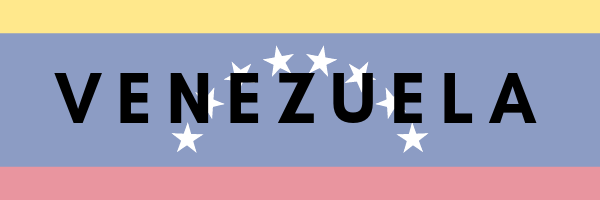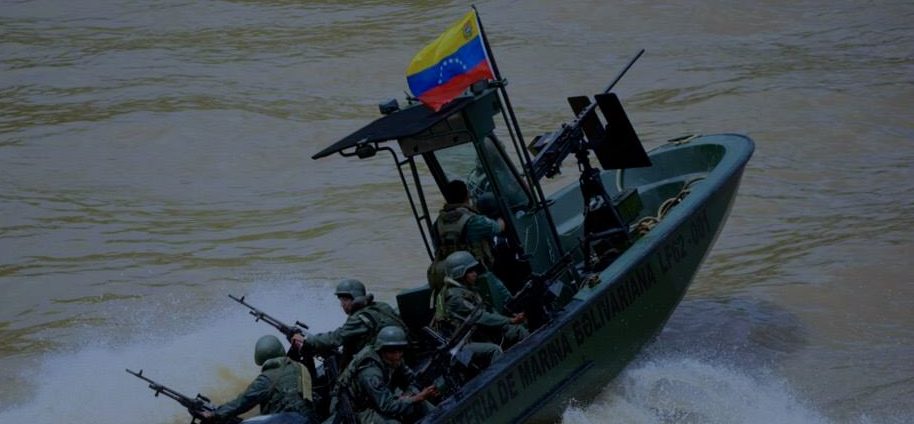EXPERT
Issues
Locations
DOWNLOAD
OVERVIEW
In the last few weeks, multiple congressional delegations have gone down to the U.S. southern border to assess the humanitarian crisis. The horrifying scene has captured the media’s attention with kids packed into holding facilities “like sardines.” But while the focus is on the U.S.-Mexico border, further south a migrant surge is brewing from Venezuela to Colombia.
The border between Colombia and Venezuela erupted into an armed conflict on March 21 after different factions of the Revolutionary Armed Forces of Colombia (FARC) began fighting over the cross-border drug trade. Months ago, the Maduro regime created an anti-drug task force, which set the stage for the regime to accuse Colombia of trafficking drugs across the border and mandating a necessary response. Maduro’s support to FARC dissidents has ensured a criminal presence at the border with Colombia and provided a pretense for Venezuela’s increased military presence. Russian troops and drones are present at the border as well, highlighting the strong VRIC external military support in Venezuela.
As the Maduro regime grows more entrenched in Venezuela it becomes the central hub for coordinated VRIC actions throughout Latin America and the Caribbean. Initially, VRIC nations carried out bilateral actions in the region but more recently we are seeing combined efforts in targeted countries further enhancing this informal alliance. In the past month, Russia and Venezuela have begun joint military drone operations; China and Iran finalize military cooperation agreements, potentially triangulating in Uruguay; and Iran and Russia craft technical cooperation agreements with Cuba. The VRIC is quickly coming together to exhibit joint capabilities in several alarming areas, including cyber, nuclear, and currently, taking advantage of the pandemic to advance joint medical diplomacy and COVID-19 disinformation throughout Latin America that further isolates the United States.
The recent aggression on the Colombian border is just a premonition of what’s to come for the strengthening alliance. The U.S. has already begun to send military support to Colombia, however, the fundamental problem is beyond a defense challenge. It has political and economic dimensions. No other region has been hit harder economically by the novel coronavirus, a state of affairs that is being exploited by the VRIC and causing problems beyond the U.S. southern border.

Rising tensions on the Colombia-Venezuela border have finally boiled over. Different factions of the Revolutionary Armed Forces of Colombia (FARC) are now fighting over control of the cross-border drug trade in Apure as the Maduro regime deploys more than 1,000 members of its security forces to the border region. Two months earlier, on February 18, Maduro announced a new Anti-Drug Law that seemingly served as a predicate for the current military maneuvers on the border.
On April 14, Colombian Foreign Minister Claudia Blum alerted the United Nations (UN) about the armed conflict on the border with Venezuela and warned about the Maduro regime’s complicit relationship with FARC dissidents fighting in Apure. Venezuela’s Defense Minister, Vladimir Padrino López, made an earlier appeal to the UN to support the Maduro regime’s military efforts in the Apure and Paéz Muñoz municipalities. A veiled reference to external support from Russian troops and mercenaries who are reportedly operating along the Colombia-Venezuela border.
Russia’s increased presence in Venezuela is accompanied by Iran. Last month, the Hong Kong-based, Liberian-flagged Calliop was once again tracked leaving Venezuela with 1.9M barrels of crude oil on behalf of the Islamic Republic, while the Maduro regime has begun shipping crude directly to China as well. The sea bridge between Iran and Venezuela is combined with an enhanced air bridge managed by Venezuelan state-owned airline Conviasa that recently expanded to 16 locations worldwide including Russia, Syria, UAE, Iran, Afghanistan, Thailand, Malaysia, China, India, and Turkey.
Regionally, Conviasa flights routinely travel to Argentina where the Alberto Fernandez government has decided to leave the Lima Group, a coalition of countries that do not diplomatically recognize Nicolás Maduro. This reversal emboldens the Maduro regime who hopes to further weaken the Lima Group in Peru’s upcoming runoff elections in June between perennial presidential candidate Keiko Fujimori and the socialist candidate Pedro Castillo. Peru is increasingly important for Maduro now that a new regional rival has emerged in Guillermo Lasso, elected on April 11 as the next president of Ecuador in a defiant setback for socialist networks throughout South America.
Click here to read media reports on the Bolivarian Threat Network

On March 30, Maduro held a meeting with a Russian delegation led by Deputy Prime Minister Yuri Ivanovich Borisov for the 15th Russia-Venezuela High-Level Intergovernmental Commission. The two countries signed 12 agreements in finance, transportation, military, agriculture, and pharmaceuticals, further strengthening the bilateral relationship. Undergirding Russia’s official presence and formal agreements with Venezuela is a strong paramilitary presence, some of which is located along the conflict-ridden Colombia-Venezuela border.
Russia’s hybrid warfare strategy promotes the use of conventional weapons with irregular forces. Recent satellite imagery shows Venezuelan troops with Russian-made rocket launchers and drones. Other images suggest the presence of Russian mercenaries embedded with the Venezuelan military. This situation has the early markings of what transpired in Crimea in 2014 when Russia annexed the territory after a hybrid military-paramilitary intervention followed by widespread unrest.
Russia has already agreed to provide security for the Maduro regime’s oil infrastructure facilities, namely those run by Rostec, the state-owned holding conglomerate based in Moscow. The Kremlin currently has military armament and technicians in no fewer than nine of Venezuela’s 23 states, including Russian-made Orlan 10B/E drones in Apure state, where the current border conflict is taking place. Shortly after the border conflict erupted, on April 1, a plane full of Russian personnel arrived at Maiquetia “Simon Bolívar” International Airport in Caracas.
As Moscow’s military continuously arrives in Venezuela, its nuclear efforts are also on the move with Maduro’s allies. The Cuba-Russia Binational Cooperation Council is inaugurated to promote joint research and scientific development projects, while, in Bolivia, the Russian state-owned company, Rosatom plans to finish the first of two installations of the Nuclear Technology Development Research Center (CIDTN) in El Alto in 2021.
Click here to read media reports on Russia in LAC

In late March, Chinese Foreign Minister Wang Yi arrived in Tehran to sign a 25-year strategic cooperation agreement announced five years earlier in 2016. A burgeoning Iran-China strategic relationship could have consequences in Latin America. A seemingly unlikely place for this cooperation is Uruguay, which may become a target for Iran-China cooperation in the region.
As Uruguay’s top trade partner, China has inordinate economic leverage on the small South American country, while Iran has built up an invisible but robust intelligence presence in Montevideo since the aftermath of the 1994 AMIA attack in Argentina. An increased presence in economic infrastructure and intelligence in Uruguay could bolster VRIC influence throughout the continent. On March 31, the Chinese and Uruguayan ambassadors to Lebanon visited Caretaker Prime Minister Hassan Diab, to mark the end of their diplomatic missions in Beirut.
As the Chinese and Uruguayan ambassadors bid farewell to Lebanon, a new Argentine ambassador arrives in Syria. Ambassador Sebastian Zavala arrived in Damascus on April 11 while back in Buenos Aires, Cristina Kirchner’s lawyer Carlos Beraldi will request the annulment of the treason case against the former president for signing a memorandum with Iran. It’s worth remembering that Syria was the host of the secret discussions between Iran and Argentina in January 2011 with the visit to Aleppo by then Argentine Foreign Minister Hector Timmerman, leading to the MOU signed in 2013 that is the focus of the treason case against Cristina Kirchner.
Meanwhile, a prominent Hezbollah financier implicated in the AMIA attack, Assad Ahmad Barakat, was convicted last week in Paraguay of immigration fraud and passport forgery and stripped of his Paraguayan citizenship. After a three-year judicial ordeal, Barakat was sentenced to time served and was deported back to Brazil.
Click here to read media reports on Iran in LAC

China advances its vaccine diplomacy with the South American soccer body, Conmebol. In a deal brokered by Uruguayan President Luis Lacalle Pou, the Chinese company Sinovac Biotech is set to donate 50,000 doses to national and club players. China will also donate 150,000 vaccines to El Salvador and a batch of vaccines was sent to the Dominican Republic on March 18. One place Chinese vaccines haven’t gone is Paraguay. Due to the country’s 63-year old alliance with Taiwan, it cannot buy directly from Chinese companies. Paraguayan officials have reported being approached by brokers to switch ties to Beijing in order to secure doses.
As China continues its medical diplomacy, so does its quest for infrastructure grabs in the region. Chile has recently awarded China Railway Construction Corporation (CRCC) a build-concession contract to upgrade and operate a 195km toll highway between cities, Talca and Chillán. In Brazil, Chinese manufacturer BYD Limited’s Bahia SkyRail is making progress, with a vehicle rolled off the production line in Shenzhen. This comes as the new Brazilian foreign minister Carlos Alberto Franco França shared a phone call with his Chinese counterpart to deepen their relationship.
While Uruguay and Brazil are working with China on infrastructure projects in their respective countries, they seem to be working against the Asian giant’s illegal fishing in the region’s exclusive economic zones. Uruguay’s Ministry of Foreign Affairs said it has been in talks with Brazil since last year to create a regional fisheries management organization (RFMO), bringing the idea to Mercosur. So far, Argentina seems to be the sticking point, not willing to commit due to the model of the proposed RFMO.
China’s illegal activities in the waters surrounding South America goes beyond fishing. China has resumed shipping Venezuelan crude after sanctions stopped them for over a year and a half. Nearly a dozen Russian firms with no previous record in oil trading have been chartered to Asia, with 248,000 bpd of crude sent to China last month making the country’s refineries an essential lifeline for the Maduro regime.
Click here to read media reports on China in LAC or more on VRIC medical diplomacy
Disclaimer: The VRIC Monitor does source a limited amount of media reports from state-owned or -controlled media outlets from VRIC nations. These media reports are carefully selected and solely intended to report on cultural, diplomatic, economic, or military activities that are not reported on by other media and relevant for understanding VRIC influence in the region. Given the inevitability that state propaganda will be mixed into these articles, we ensure that reporting from state-media outlets is no more than 20 percent of the overall VRIC Monitor and exclude any opinion pieces or anti-US (anti-West) declarations of any kind.


 Christina Armes Hunter
Christina Armes Hunter